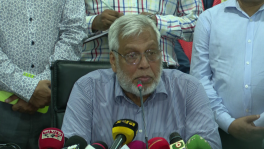Outdoor air purifier: Why try an experimental cure when prevention is the answer?
Experts argue that such symbolic measures distract from more impactful actions like reducing emissions at the source, enforcing environmental regulations and expanding green spaces

Almost every morning, a glance at the AQI index tells the same story — Dhaka ranking among the top cities in the world with the worst air quality.
In fact, Dhaka ranked third on that list on Wednesday morning too, with an AQI score of 189. The air was classified as 'unhealthy', raising concerns about severe health threats.
The air pollution crisis has largely been normalised, prompting little urgency or effort toward finding a real solution.
But the Dhaka North City Corporation seems to have finally come up with an unprecedented solution that has left many scratching their heads — installing outdoor air purifiers.
On Monday, Dhaka North administrator Mohammad Azaz announced that they are planning to install air purifiers at 50 locations across the capital to tackle Dhaka's worsening air pollution.
Azaz highlighted that each purifier would be capable of purifying and cooling the air equivalent to the function of approximately 100 trees.
"The air purifiers will be placed in various public spaces. Each device will purify the air like a hundred trees. We are moving towards such engineering solutions. While quick fixes are necessary, we are also working on long-term sustainable solutions," he said at an event.
No more details were provided about how these air purifiers would actually function.
Experts, naturally, are on the fence about the plan.
"There is no single machine, no shortcut, no 'magic fix' for air pollution," said Boudewijn Sterk, founder of Smart Air Bangladesh.
"Only strong policy enforcement and systemic reform work. Moreover, if these expensive devices fail or underperform — which global experience suggests they likely will — it could undermine public trust not only in Dhaka North, but also in future tech-based solutions that Bangladesh urgently needs," he added.
Sterk pointed to Delhi, where outdoor smog towers were installed during the 2010 Commonwealth Games.
Clean air expert Dr Sarath Guttikunda calculated that a large outdoor smog tower in Delhi — even assuming 100% efficiency — could purify only 0.000072% of the total volume of city air per hour.
Years later, the experiment was considered as having failed to deliver meaningful city-wide improvements.
Professor Ahmad Kamruzzaman Majumder, joint secretary of Bangladesh Poribesh Andolon (BAPA) and chairman of Center for Atmospheric Pollution Studies (CAPS), believes that air purifiers can never be an alternative to trees and green spaces.
"This is by no means a definitive solution to Dhaka's air pollution problem," he added.
But he appreciates this initiative in the sense that it allows the authorities to experimentally assess how effective it might be.
Shaikh Muhammad Mehedi Ahsan, general secretary at the Bangladesh Institute of Planners (BIP), also believes that it might not be effective in a polluted city like Dhaka.
"Therefore, before going for this system, the city corporation can install it in a few experimental places and take the output from there and take the next step," he said.
The idea is still at the research and development stage around the world, and there is no grand successful case study of its implementation in any country.
Rather, there have been examples of failed cases in other countries.
China, for instance, experimented with installing giant outdoor 'smog-free towers' in its polluted cities. It initially generated interest in 2016 but failed to deliver the desired results. Two years later, the country built another one — the world's largest air purifier. While these towers hold potential for providing clean air to surrounding communities, research suggests that their impact remains limited to local areas.
Sterk believes that the idea signals a growing and much-needed urgency about Dhaka's worsening air pollution crisis, but the emphasis is misplaced.
"While symbolic installations can raise awareness, it's far more effective — and far more urgent — to reduce emissions at their source, rather than trying to purify the air after pollution has already been released," he said.
Ahsan suggests that expanding green spaces and preserving existing ones along with the adjacent water bodies would be a more effective approach than installing air purifiers.
Air purifiers are highly effective inside enclosed spaces, such as homes, classrooms, or hospitals — where they can cycle and clean a limited volume of air. But outdoors, where billions of cubic metres of air move continuously across a sprawling city, even the largest purifiers are almost ineffective.
If outdoor air purifiers must be installed, Sterk strongly urges to prioritise enclosed sensitive environments where the benefits will be real and measurable, such as schools, hospitals, and health centres.
Dhaka North authorities say they have secured sponsors to fund the installation of all 50 purifiers, meaning the city corporation will not have to bear any cost. However, for large-scale implementation, management and cost issues will need to be carefully considered before adopting such technology.
But the solution to Dhaka's air pollution is not rocket science. If Dhaka truly wants cleaner air, the priorities are clear: strict control and modernisation of brick kilns, enforcing dust control protocols at construction sites, mandatory emissions testing for vehicles, and strict bans and enforcement against waste burning.
Ahsan suggests taking multiple actions to reduce air pollution in Dhaka. The first thing is to plan what to do in the immediate, medium and long term to prevent pollution. Steps will have to be taken on how to stop the sources of pollution.
Dr Majumder highlights that the Department of Environment is responsible for monitoring pollution, while the city corporations can address the root cause — preventing pollution in the first place, as various projects are implemented with its approval.


 Keep updated, follow The Business Standard's Google news channel
Keep updated, follow The Business Standard's Google news channel
















